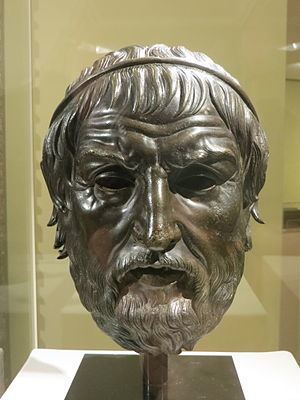Material Bronze Created 2nd-1st Century BC | Size 29.5 cm high | |
 | ||
Registration GR 1760.9-19.1 (Bronze 847) Similar Apollo of Piombino, Croatian Apoxyomenos, Satala Aphrodite, Chatsworth Head, The Orator | ||
The Arundel Head is an Hellenistic bronze portrait of a dramatist or king from Asia Minor, now kept in the British Museum. Dating to the 2nd-1st centuries BC, the head once belonged to (and takes its name from) the famous English collector of classical antiquities, Thomas Howard, 21st Earl of Arundel.
Contents
Description
The head is all that remains of a life-size bronze statue. The artist has realistically conveyed the worn features of an old man, including a wrinkled forehead, almond-shaped eyes and pouting mouth, which gives the portrait an air of power and authority. The hair of this bronze masterpiece is tied down in a ribbon, which suggests it may have portrayed a poet. Once thought to represent the ancient Greek writer Homer, it is currently considered to personify either the ancient Greek playwright Sophocles or a Macedonian King.
Provenance
Recent research has suggested that the Arundel Head may have originally been found in Smyrna, the ancient name for Izmir in Turkey. The bronze sculpture was brought to England from Constantinople in the early seventeenth century as part of the collection of Thomas Howard, 21st Earl of Arundel. Subsequently it came into the possession of Dr Richard Mead and later Brownlow Cecil, 9th Earl of Exeter, who donated it to the British Museum in 1760, making it one of the earliest pieces of classical antiquities to enter the national collection.
